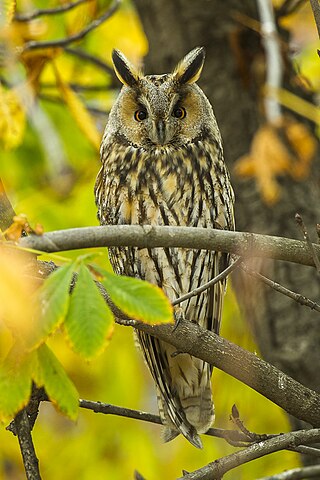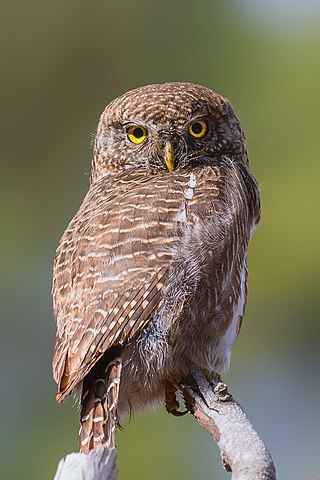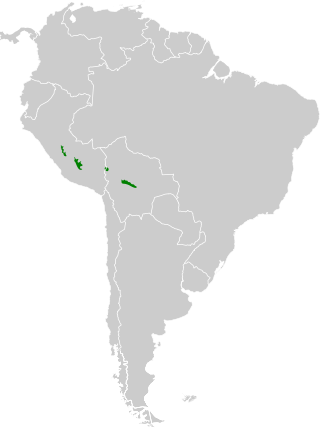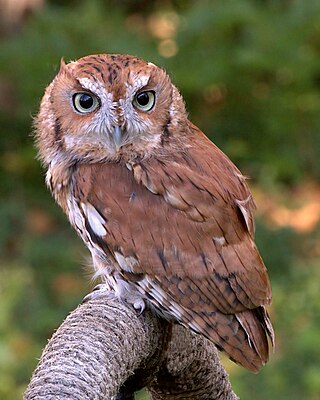
The long-eared owl, also known as the northern long-eared owl or, more informally, as the lesser horned owl or cat owl, is a medium-sized species of owl with an extensive breeding range. The scientific name is from Latin. The genus name Asio is a type of eared owl, and otus also refers to a small, eared owl. The species breeds in many areas through Europe and the Palearctic, as well as in North America. This species is a part of the larger grouping of owls known as typical owls, of the family Strigidae, which contains most extant species of owl.

The eastern screech owl or eastern screech-owl, is a small owl that is relatively common in Eastern North America, from Mexico to Canada. This species is native to most wooded environments of its distribution, and more so than any other owl in its range, has adapted well to manmade development, although it frequently avoids detection due to its strictly nocturnal habits.

Scops owls are typical owls in family Strigidae belonging to the genus Otus and are restricted to the Old World. Otus is the largest genus of owls with 59 species. Scops owls are colored in various brownish hues, sometimes with a lighter underside and/or face, which helps to camouflage them against the bark of trees. Some are polymorphic, occurring in a greyish- and a reddish-brown morph. They are small and agile, with both sexes being compact in size and shape. Female scops owls are usually larger than males.

The flammulated owl is a small migratory North American owl in the family Strigidae. It is the only species placed in the genus Psiloscops.

The Japanese scops-owl is a small owl species in the family Strigidae, or true owl family. It is a member of the genus Otus, the scops owl genus. It is resident to Japan, China, Korea, and Russia.

The Philippine scops owl is a common owl, endemic to the Philippines, belonging to the family of the typical owls Strigidae. Other common names include "Otus Whitehead", "Whitehead scops owl" and "Luzon lowland scops owl". Everett's scops owl and Negros scops owls were formerly considered conspecific but are now classified as separate species.

The Puerto Rican owl or múcaro común, formerly known as the Puerto Rican screech owl, is a mid-sized "typical owl" in subfamily Striginae. It is endemic to the archipelago of Puerto Rico though it formerly also inhabited the Virgin Islands.

The whiskered screech owl is a small screech owl found in North and Central America.

The Asian barred owlet also known as the Cuckoo owlet is a species of pygmy owl native to the forests and shrublands of mainland Southeast Asia to the foothills of the Himalayas of northern Pakistan. It is a smaller owl, measuring 22–25 cm (8.7–9.8 in) making it one of the larger pygmy owls. They are primarily insectivorous but will eat lizards, small rodents and birds as well.

The black-capped screech owl, or variable screech owl, is a species of owl in the family Strigidae. It is found in Argentina, Brazil, and Paraguay.

The bearded screech owl is a small "typical owl" in subfamily Striginae. It is found in Guatemala and Mexico.

The tropical screech owl is a small species of owl in the family Strigidae. It is found in Costa Rica, Panama, Trinidad, and every mainland South American country.

The Pacific screech owl is a species of owl in the family Strigidae. It is found in Costa Rica, El Salvador, Guatemala, Honduras, Mexico, and Nicaragua. The Pacific screech owl has sometimes been treated as a race of western screech owl or eastern screech owl but its vocalizations are distinct from theirs. Two subspecies are recognized, the nominate M. c. cooperi and M. c. lambi. The latter has also sometimes been treated as a separate species. The IUCN has assessed the Pacific screech owl as being of Least Concern. Its population is estimated to exceed 50,000 mature individuals but is believed to be decreasing.

The rufescent screech owl is a species of owl in the family Strigidae. It is found in Bolivia, Colombia, Ecuador, Peru, and Venezuela.

The cloud-forest screech owl is a species of owl in the family Strigidae. It is found in Bolivia and Peru.

The long-tufted screech owl is a species of "typical owl" in the subfamily Striginae. It is found in Argentina, Brazil, and Uruguay.

The Balsas screech owl is a species of owl in the family Strigidae. It is endemic to Mexico.

Screech owls are typical owls (Strigidae) belonging to the genus Megascops with 23 living species. For most of the 20th century, this genus was merged with the Old World scops owls in Otus, but nowadays it is again considered separately based on a range of behavioral, biogeographical, morphological, and DNA sequence data.

The Chocó screech owl is a species of owl in the family Strigidae. It is found from central Panama to western Ecuador.

























